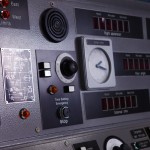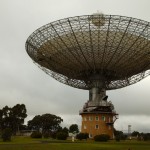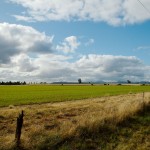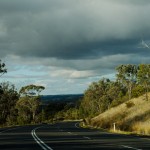Like we mentioned yesterday, early out of bed today to be on the road just before sunrise. We arrived in Parkes around 0830 to get to the laundromat and clean some clothes. Chantal hug around the laundry while I walked up to Subway to pick up breakfast. We discovered that when the dryer says it is set to hot, it means really really hot. The clothes were starting to cook I think and we had to watch out not to touch any of the metal bits on the jeans when they came out! By 0930 we were back on on our way towards the CSIRO Parkes Observatory.
For those of you who have seen the movie ‘The Dish’, you will recognize the dish in my photo, as this is the site the movie is all about! For those of you who haven’t, CSIRO Parkes Observatory is a radio telescope built in 1961 for planetary observation. It has been upgrade throughout the years and is still in use, with some 85% of the years’ hours set aside for scientific use, the other 15% used for maintenance and testing. It is used by scientists all over the world, and is the telescope model (designed in Australia) that NASA used for all of its Deep Space Network telescopes. The Parkes Observatory’s big claim to faim, is that back in 1969, it was the feed from this station that was used to televise almost the entire two and a half hours of the first moon landing to everyone around the world (For the first few minutes the feed from from two stations in the US operated by NASA). If you haven’t seen the movie, I would recommend it. It’s not 100% accurate, as it is a movie, but it is pretty close. The picture of the control console is from the set made for the movie, which was donated to the center when they finished production.
From the Parkes Observatory we hit the road yet again, this time on slightly more interesting roads, if still filled with cows and sheep, to get to Coonabarabran. It turns out Coonabarabran is the ‘astronomy capital of Australia’ due to it’s low levels of ambient light and normally clear skies. Our purpose of being here is to hike in nearby Warrumbungle Nation Park (which we will do tomorrow), however I am looking into going to a local observatory tomorrow night from a lesson in the night sky.
Just an FYI: I added some photos to last evenings update to include a photo of us with Kate as well as some birds that Chantal took.
-John
Nous avons fait tel qu’indiqué dans nos plans hier… lever tôt et nous étions sur la route juste avant le lever du soleil. La boule de feu orangée s’est levée devant nous, entre quelques nuages qui parsemaient le ciel. Le thermomètre de la voiture est descendu jusqu’à 3 degrés ce matin. En arrivant à Parkes, nous nous sommes dirigés vers la buanderie… durant que je regardais la laveuse faire le travail, John est allé chercher le déjeuner chez Subway. Vers 9h30, quand tout était propre et très sec, le linge a séché trop longtemps à haute température (sécheuse trop efficace), nous avons poursuivi la route vers le CSIRO Parkes Observatory.
Je doute que ma famille est vue le film ‘The Dish’… Tel que vous le verrez sur la photo, le dish est un télécospe radio construit en 1961 pour l’observation des planètes. Depuis, il a vécu des phases de mise à niveau. Il est toujours en utilisation, avec 85% du temps d’utilisation pour les recherches scientifiques et 15% du temps restant pour la maintenance (comme c’était le cas aujourd’hui). Comme le film en fait foi, le moment marquant de la vie de ce télescope fut en 1969 lorsque Neil Amrstrong a marché sur la Lune. Les 8 premières minutes de ce moment ont été diffusées par la NASA, mais le reste des 2.5 heures du vidéo, c’est le centre de Parkes qui a pris la relève, offrant une meilleure qualité d’images. Le contrôle construit pour le film (voir photo) fut donné au centre d’observation. John et moi prévoyons louer le film lorsque nous retournerons à Vancouver.
Après Parkes, nous avons poursuivi la route vers Dubbo pour le lunch. Ensuite, en route vers Coonabarabran (appelé Coona par les locaux). La route était très intéressante. Toujours les champs de chaque côté, couverts par les vaches (noires et brunes), et des moutons (tout blanc, blanc à tête noire, ou merino (plus tan de couleur)). Tout à coup, des montagnes se sont pointées à l’horizon. C’est le parc que nous prévoyons explorer demain. Le Parc National Warrumbungle. Nous demeurons à Coonabarabran pour 2 nuits. En arrivant en ville (village!), nous avons découvert que le Parc est la Capitale Australienne de l’Astronomie. John a trouvé un site web qui annonce un tour à l’observatoire du Parc National, avec un homme qui connaît beaucoup du ciel et des télescopes. Nous tentons d’avoir un tour avec lui demain soir.
PS: John a ajouté des photos sur le post d’hier. La fille entre nous sur la photo est Kate. J’ai pris la photo des oiseaux. J’étais vraiment contente d’en voir un groupe, et John a fait demi-tour pour que je puisse les poser.
– Chantal



